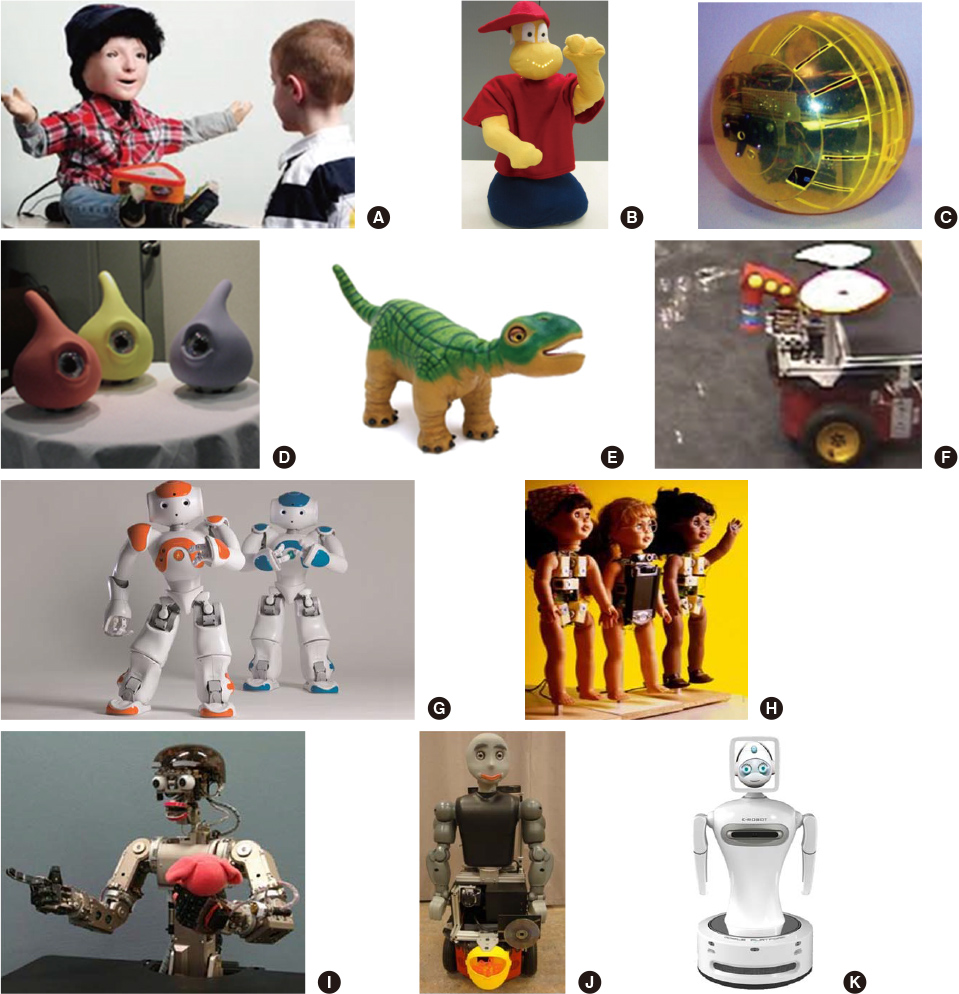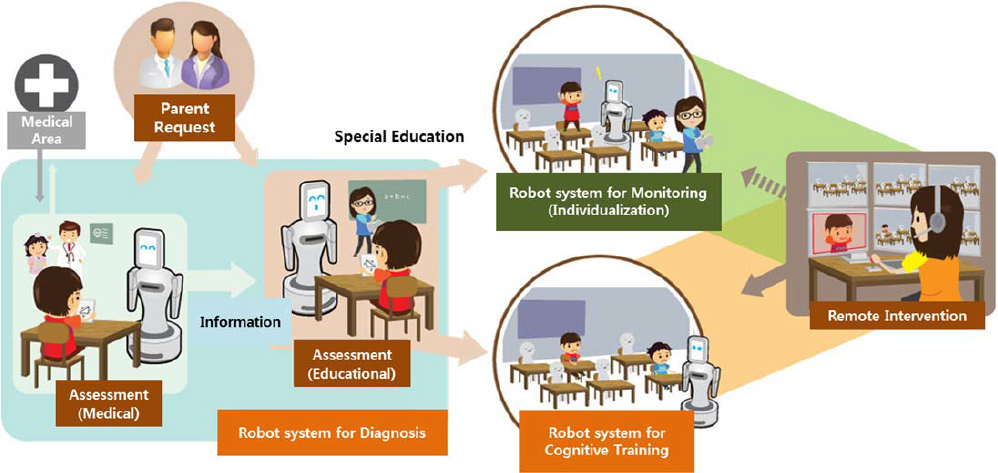Hanyang Med Rev.
2016 Feb;36(1):17-26. 10.7599/hmr.2016.36.1.17.
Socially Assistive Robotics in Autism Spectrum Disorder
- Affiliations
-
- 1Department of Psychiatry, Hanyang University Medical Center, Seoul, Korea.
- 2Department of Psychiatry, College of Medicine and Institute of Mental Health, Hanyang University, Seoul, Korea. ahndh@hanyang.ac.kr
- KMID: 2168368
- DOI: http://doi.org/10.7599/hmr.2016.36.1.17
Abstract
- Autism spectrum disorder (ASD) is a neurodevelopmental disorders that is characterized by complex behavioral phenotype and deficits in both social and cognitive functions and has been gradually increasing for the past 20 years. However, practically there are some difficulties in diagnosis and treatment due to a limited number of specialist and considerable cost. Emerging technology, especially socially assistive robotics (SAR), has expanded into the evaluation and intervention for children with ASD. SAR refers to a robot that provides assistance to the user in a social interaction setting. SAR becomes a tool that can teach or demonstrate socially desirable behaviors to help children who have trouble expressing themselves to others owing to their underdeveloped communication and social skills as a result of ASD. This paper reviews the use of SAR to assist in the therapy of children with ASD and the extent to which the robots were successful in helping the children in their social, emotional and communication deficits was investigated. The study investigates the different roles that these robots were observed to play with children with ASD by categorizing and the outcome of studies that have been conducted in Korea. Despite the fact that SAR research is still in its formative stages, if rigorous research plans are developed based on clinical usefulness and effectiveness, and if a clinician with specialized knowledge of ASD participates in or evaluates the results of the research, there is the possibility to create a new paradigm for the treatment of ASD.
MeSH Terms
Figure
Cited by 1 articles
-
Introduction: Neurodevelopmental Disorders
Dong Hyun Ahn
Hanyang Med Rev. 2016;36(1):1-3. doi: 10.7599/hmr.2016.36.1.1.
Reference
-
1. Elsabbagh M, Divan G, Koh YJ, Kim YS, Kauchali S, Marcín C, et al. Global prevalence of autism and other pervasive developmental disorders. Autism Res. 2012; 5:160–179.
Article2. Developmental Disabilities Monitoring Network Surveillance Year 2010 Principal Investigators. Centers for Disease Control and Prevention (CDC). Prevalence of autism spectrum disorder among children aged 8 years-autism and developmental disabilities monitoring network, 11 sites, United States, 2010. MMWR Surveill Summ. 2014; 63:1–21.3. Autism and Developmental Disabilities Monitoring Network Surveillance Year 2006 Principal Investigators. Centers for Disease Control and Prevention (CDC). Prevalence of Autism Spectrum Disorders: autism and Developmental Disabilities Monitoring Network, United States, 2006. MMWR Surveill Summ. 2006; 58:1–20.4. Autism and Developmental Disabilities Monitoring Network Surveillance Year 2008 Principal Investigators. Centers for Disease Control and Prevention. Prevalence of Autism Spectrum Disorders: autism and Developmental Disabilities Monitoring Network, 14 Sites, United States, 2008. MMWR Surveill Summ. 2008; 61:1–19.5. Eikeseth S. Outcome of comprehensive psycho-educational interventions for young children with autism. Res Dev Disabil. 2009; 30:158–178.
Article6. Feil-Seifer D, Mataric MJ. Defining socially assistive robotics. In : 9th International Conference on Rehabilitation Robotics; 2005; ICORR;2005. p. 465–468.7. Fong T, Nourbakhsh I, Dautenhahn K. A survey of socially interactive robots. Robot Auton Syst. 2003; 42:143–166.
Article8. Rabbitt SM, Kazdin AE, Scassellati B. Integrating socially assistive robotics into mental healthcare interventions: applications and recommendations for expanded use. Clin Psychol Rev. 2015; 35:35–46.
Article9. Libin A, Cohen-Mansfield J. Therapeutic robocat for nursing home residents with dementia: preliminary inquiry. Am J Alzheimers Dis Other Demen. 2004; 19:111–116.
Article10. Marti P, Bacigalupo M, Giusti L, Mennecozzi C, Shibata T. Socially Assistive Robotics in the treatment of behavioural and psychological symptoms of dementia. In : The First IEEE/RAS-EMBS International Conference on Biomedical Robotics and Biomechatronics; 2006; BioRob;2006. p. 483–488.11. Wada K, Shibata T, Saito T, Tanie K. Effects of robot-assisted activity for elderly people and nurses at a day service center. Proc IEEE. 2004; 92:1780–1788.
Article12. Kanamori M, Suzuki M, Oshiro H, Tanaka M, Inoguchi T, Takasugi H, et al. Pilot study on improvement of quality of life among elderly using a pet-type robot. In : 2003 IEEE Int Symp Comput Intell Robot Autom; 2003. 1:p. 107–112.13. Atherton JA, Goodrich MA. Supporting clinicians in robot-assisted therapy for autism spectrum disorder: creating and editing robot animations with full-body motion tracking. In : Workshop on Human-robot interaction: perspectives and contributions to robotics from the human sciences; 2011 Jul; Los Angeles(CA), USA: 2011.14. Tapus A, Tapus C, Mataric MJ. The use of socially assistive robots in the design of intelligent cognitive therapies for people with dementia. In : IEEE International Conference on Rehabilitation Robotics; 2009; ICORR;2009. p. 924–929.15. Scassellati B, Admoni H, Matarić M. Robots for use in autism. Res Annu Rev Biomed Eng. 2012; 14:275–294.16. Robins B, Dautenhahn K, Dubowski J. Does appearance matter in the interaction of children with autism with a humanoid robot? Interact Stud. 2006; 7:509–542.
Article17. Giullian N, Ricks D, Atherton A, Colton M, Goodrich M, Brinton B. Detailed requirements for robots in autism therapy. In : 2010 IEEE Int Conf Syst Man Cybern SMC; 2010. p. 2595–2602.18. Cabibihan JJ, Javed H, Ang M Jr, Aljunied SM. Why Robots? A survey on the roles and benefits of social robots in the therapy of children with autism. Int J Soc Robot. 2013; 5:593–618.
Article19. Fakhoury M. Autistic spectrum disorders: a review of clinical features, theories and diagnosis. Int J Dev Neurosci. 2015; 43:70–77.
Article20. Diehl JJ, Schmitt LM, Villano M, Crowell CR. The clinical use of robots for individuals with Autism Spectrum Disorders: a critical review. Res Autism Spectr Disord. 2012; 6:249–262.
Article21. Dautenhahn K. Roles and functions of robots in human society: implications from research in autism therapy. Robotica. 2003; 21:443–452.
Article22. Johnson CP, Myers SM. Identification and Evaluation of Children With Autism Spectrum Disorders. Pediatrics. 2007; 120:1183–1215.
Article23. Duquette A, Michaud F, Mercier H. Exploring the use of a mobile robot as an imitation agent with children with low-functioning autism. Auton Robots. 2007; 24:147–157.
Article24. Robins B, Dautenhahn K, Boekhorst R te, Billard A. Effects of repeated exposure to a humanoid robot on children with autism. In : Keates S, Clarkson J, Langdon P, Robinson P, editors. Designing a More Inclusive World. London: Springer;2004. p. 225–236.25. Robins B, Dautenhahn K, Boekhorst RT, Billard A. Robotic assistants in therapy and education of children with autism: can a small humanoid robot help encourage social interaction skills? Univers Access Inf Soc. 2005; 4:105–120.
Article26. Ferrari E, Robins B, Dautenhahn K. Therapeutic and educational objectives in robot assisted play for children with autism. In : The 18th IEEE International Symposium on Robot and Human Interactive Communication; 2009; RO-MAN;2009. p. 108–114.27. Bekele E, Lahiri U, Davidson J, Warren Z, Sarkar N. Development of a novel robot-mediated adaptive response system for joint attention task for children with autism. In : 20th IEEE international symposium on robot and human interactive communication; 2011; IEEE RO-MAN;2011. p. 276–281.28. Bekele ET, Lahiri U, Swanson AR, Crittendon JA, Warren ZE, Sarkar N. A step towards developing adaptive robot-mediated intervention architecture (ARIA) for children with autism. IEEE Trans Neural Syst Rehabil Eng. 2013; 21:289–299.
Article29. Costa S, Santos C, Soares F, Ferreira M, Moreira F. Promoting interaction amongst autistic adolescents using robots. In : Engineering in Medicine and Biology Society (EMBC), 2010 Annual International Conference of the IEEE; 2010. p. 3856–3859.30. Werry I, Dautenhahn K, Ogden B, Harwin W. Can social interaction skills be taught by a social agent? The role of a robotic mediator in autism therapy. In : Beynon M, Nehaniv CL, Dautenhahn K, editors. Cognitive Technology: Instruments of Mind. Heidelberg: Springer;2001. p. 57–74.31. Robins B, Dautenhahn K, Dickerson P. From Isolation to Communication: a Case Study Evaluation of Robot Assisted Play for Children with Autism with a Minimally Expressive Humanoid Robot. In : The Second International Conferences on Advances in Computer-Human Interactions; ACHI;2009. p. 205–211.32. Klin A, Jones W, Schultz R, Volkmar F, Cohen D. VIsual fixation patterns during viewing of naturalistic social situations as predictors of social competence in individuals with autism. Arch Gen Psychiatry. 2002; 59:809–816.
Article33. Jordan K, King M, Hellersteth S, Wirén A, Mulligan H. Feasibility of using a humanoid robot for enhancing attention and social skills in adolescents with autism spectrum disorder. Int J Rehabil Res. 2013; 36:221–227.
Article34. Kim ES, Paul R, Shic F, Scassellati B. Bridging the research gap: making HRI useful to individuals with autism. J Hum-Robot Interact. 2012; 1:26–54.
Article35. Lee HS, Kang WS, Bae MJ, Jang SJ, Kim KH, Kang JB. Exploring responses of children labeled with autism to auditory, visual and tactile stimuli through interacting with a robot. J Emot Behav Disord. 2010; 26:371–399.36. Kim CG, Kim KH, Lee HS, Song BS. Development of an integrated stimuli robot for the selection of the preferred stimuli of children with autism spectrum disorders. J Spec Educ Rehabil Sci. 2011; 50:353–367.37. Kim CG, Lee HS, Shin YH, Kang JB, Kim MS, Choi MT. Establishment of remote support system for children with cisabilities through the use of robots. J Spec Educ Rehabil Sci. 2012; 51:327–347.38. Radecki L, Sand-Loud N, O'Connor KG, Sharp S, Olson LM. Trends in the use of standardized tools for developmental screening in early childhood: 2002-2009. Pediatrics. 2011; 128:14–19.
Article39. Scassellati B. Quantitative metrics of social response for autism diagnosis. In : IEEE International Workshop on Robot and Human Interactive Communication; 2005; ROMAN;2005. p. 585–590.
- Full Text Links
- Actions
-
Cited
- CITED
-
- Close
- Share
- Similar articles
-
- The Translation of the Term 'Autism Spectrum Disorder' in Korean
- Screening Instruments for Autism Spectrum Disorder: Mini Review
- Comparison of the Autism Diagnostic Observation Schedule and Childhood Autism Rating Scale in the Diagnosis of Autism Spectrum Disorder: A Preliminary Study
- Review of Early Intervention for Children with Autism Spectrum Disorder: Focused on Randomized Controlled Trials
- Genetics of Autism Spectrum Disorder: Current Status and Possible Clinical Applications





